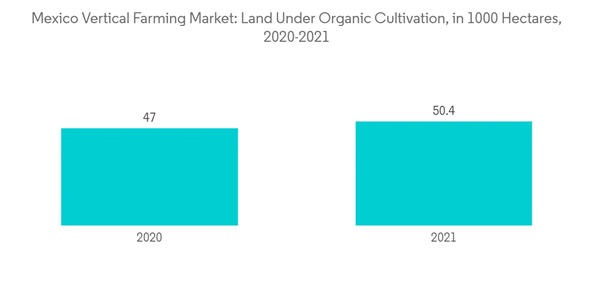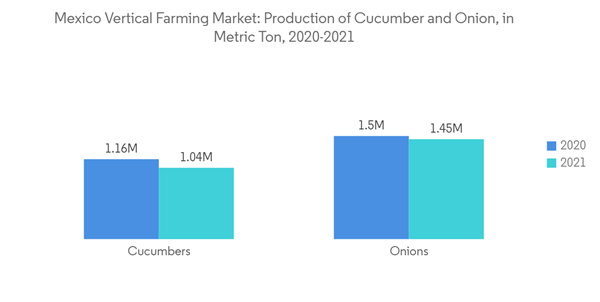Key Highlights
- The increasing water scarcity and reduction in agricultural land area, focus on food security, and the need for alternative farming techniques are major drivers that have paved the way for the development of vertical farming in Mexico. Major crops produced in the country under vertical farms are lettuce, leafy vegetables, microgreens, tomato, cucumber, etc. Lighting devices and climate control are the major component types in vertical farms. Since farming is done in indoor conditions, providing proper and adequate lighting, along with the right environmental conditions, becomes crucial for the growth of plants.
- In terms of quantity, most indoor farms in Mexico focus on leafy vegetables and microgreens. However, with the increasing R&D on different varieties of produce, the trend is set to change rapidly. Companies are pioneering vertical farming and working on getting systems and knowledge to the new generation of agronomists. The Mexican government is paying attention to new technologies and revising university programs.
- The National Consumer Price (NCP) index saw a dramatic rise in fresh goods in 2022. Inflation and challenges with basic food products are increasing hunger among the poorest people. Vertical farming can promote food security and help reduce food insecurity in the country. Hydroponics is the most adopted vertical farming technique, followed by aeroponics and aquaponics. Compared to other methods, hydroponics has a relatively low investment.
- The country's agriculture production structure has a heterogeneous landscape, translating into low productivity growth over the past few years. Thus, vertical farming can provide a sustainable long-term solution to increasing agriculture productivity in the country. Therefore, market growth is expected to be positive during the forecast period.
Mexico Vertical Farming Market Trends
Growth in Organic Cultivation Practices
- Mexico's preference for organic farming has grown significantly over the past ten years, and there is no sign of slowing down. Growers of all sizes are improving production on practically every crop grown in Mexico.
- Organic product demand in Mexico has increased in recent years, paralleling a general trend toward healthy eating. Many Mexican consumers consider organic foods healthier than conventionally farmed foods to avoid environmental damage and promote better soil and plants.
- According to Statistics from the Government of Mexico, the total organic land under cultivation in 2021 was 50.4 thousand hectares. Mexican authorities have officially recognized organic farmers who wish to use more intensive commercial production techniques, like vertical farming, and provided them with protection from conventional farmers. Vertical farming reduces the use of synthetic fertilizers, pesticides, and other hazardous chemicals.
- Although the country produces a substantial amount of vegetable crops, it is more attracted to plantation and fruit crops. Vertical farming, in this case, is a good alternative for growers who wish to produce and fulfill the demand for organic vegetables.
- Several attempts have been made in the recent decade by the Mexican government and the commercial sector to promote organic farming. As a result, dozens of outdoor markets and farmers' markets for organic products have sprouted up across Mexico, including Oaxaca, Michoacán, and Chiapas, with over 500 small producers selling their wares.
Increased Focus on Food Security
- In Mexico, the diverse food, nutrition, and public health issues are handled separately by different agencies with differing political power and capabilities. Fragmentation creates confusion and is likely responsible for Mexico's weak state of food security governance. However, reforms are being implemented by the government.
- The National Population Council of Mexico (NPCM) estimates that the average population of Mexico will exceed 145 million people by 2050. This will put immense pressure on the country's agricultural system to provide food for the entire country and rely on imports. According to International Trade Center (ITC) Trademap statistics, Mexico imported USD 662,081 thousand worth of vegetables in 2019 to fulfill the domestic market demand, which has increased by approx 20% as compared to the previous year, 2018.
- Certain commodities in the country are witnessing decreasing production, including spinach, cucumbers, onions, and peas. The reason is mainly attributed to the need to increase technological involvement to maintain production levels. Hence, the increasing demand for food security requires bold and innovative technologies like vertical farming. Since the focus on this issue will only increase with the country's population, the Mexican vertical farming market is projected to witness gradual growth in the coming years.
Mexico Vertical Farming Industry Overview
The Mexican vertical farming market is highly consolidated, with the top players occupying a major share of the market. The major players in the Mexican vertical farming market are Signify Holding, Heliospectra AB, Inverfarms Mexico, Karma Verde Fresh, and Verde Compact, among others. As vertical farming in Mexico is at a nascent stage, stakeholders, including direct customers, are willing to experiment with products that suit best.Additional Benefits:
- The market estimate (ME) sheet in Excel format
- 3 months of analyst support
This product will be delivered within 2 business days.
Table of Contents
Companies Mentioned (Partial List)
A selection of companies mentioned in this report includes, but is not limited to:
- Signify Holding (Philips)
- Heliospectra AB
- Karma Verde Fresh
- Verde Compacto
- Comercializadora Hydro Environment, S.A. De C.V.
- Al Natural
- Oasis Grower Solutions
- Inverfarms Mexico
- Aeroponia Mexicana










